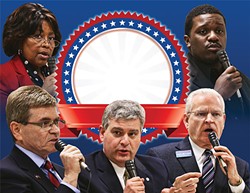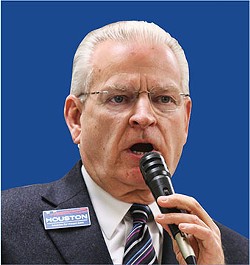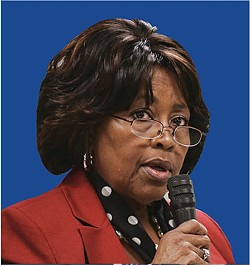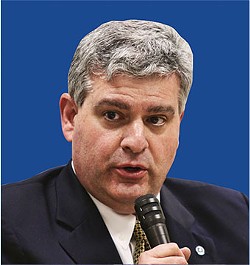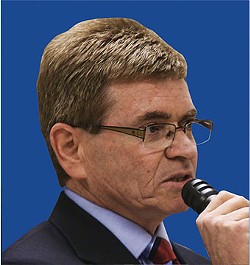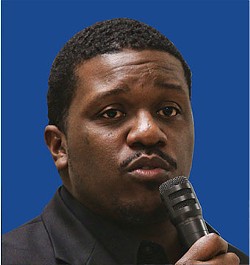Allan Woodson was one of Springfield’s first black aldermen and the last black person to run for mayor. Following a historic voting rights lawsuit and resulting transition from the commission form of city government in 1987, Woodson and former alderman Frank McNeil, also African-American, were elected to the newly formed city council. It was such a big deal that even the New York Times ran an article on it.
Woodson says many of the problems facing people of color on Springfield’s east side – poor infrastructure, lack of black-owned businesses, inadequate affordable housing and more – haven’t changed since his 1999 loss to now-former mayor Karen Hasara. However, one thing has changed: candidates for mayor in this election are paying unprecedented attention to the needs of the east side. Woodson attributes it in part to the high-profile killings of Michael Brown and Eric Garner, two black men who were killed by police in 2014. Those cases and others like them spawned a nationwide debate on race and focused attention on government relations with communities of color, Woodson said.
Additionally, the presence of two African-American mayoral candidates and an intense effort by east side groups to mobilize black voters have made overlooking the east side politically perilous. The east side could be a priority for the next mayor – assuming the winning candidate keeps her or his campaign promises.
Springfield Mayor Michael Houston is running for re-election, facing questions about what he promised four years ago and what he has delivered for the east side. Meanwhile, the other four candidates are making their own promises. [See “The candidates,” below.]
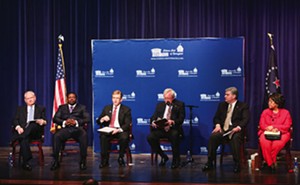
It’s natural for an incumbent candidate for re-election to defend his record in office, and a mayoral candidate forum on Jan. 26 found Houston fending off criticism – sometimes veiled and sometimes direct – of his policy decisions.
The issue of a residency requirement for city employees is one of the most divisive policy questions in the election, and Houston supported such a requirement during his 2011 campaign. However, he now defends his stance that the city can’t implement such a requirement without incurring untenable costs. He says a residency requirement would be disputed by the 24 unions representing city employees, and the issue would go to arbitration and possibly prompt a strike at City Water, Light and Power. The result, Houston forecasts, would be an agreement in which the unions accept a residency requirement in return for higher salaries. Those prospective pay increases and the costs associated with possible union strikes would be expensive for the city, Houston said.
For residents of the east side, the issue is one of fairness: the city’s record of hiring minority workers in proportion with their share of the population is poor at best, and people of color see city jobs going to white people who live in bedroom communities outside Springfield instead of people of color who live within the city. At the Jan. 26 candidate forum, the four candidates who said they support a residency requirement got applause. Meanwhile, the crowd grumbled in disapproval as Houston explained why he hasn’t already implemented it.
Related to the residency requirement issue is minority hiring. Houston distributed a handout at the Jan. 26 candidate forum saying 20.2 percent of new hires in his administration have been nonwhite workers. If tested positions like police and fire jobs are excluded, that number jumps to 24 percent, according to Houston’s campaign. Looking at 2014 alone, Houston says 25.6 percent of all new hires have been nonwhite workers, and 32.1 percent of hires in untested positions were nonwhite.
In June 2011, shortly after Houston took office, 7.8 percent of city employees were nonwhite, Houston’s campaign says. That number increased to 9.7 percent by June 2014, according to the campaign.
When Houston ran for mayor four years ago, he promised to hire 25 percent minority employees for the first two years of his administration and reevaluate hiring numbers after that. Houston’s cumulative minority hiring numbers for all four years appear below the 25 percent mark, although his minority hiring numbers for 2014 alone are significantly higher.
Houston also says he has “revamped” how hiring works in city government, with a human resources worker sitting in on every interview and a standardized list of questions asked of each candidate. He says he has met with several community groups associated with the east side, and his administration sends job listings to those groups, along with posting them on websites aimed at employment diversity.
“We showed you exactly what we have done over the last four years to improve the minority participation within city government,” Houston said. “We are operating a professional organization, and not a political organization.”
Ward 2 Ald. and mayoral candidate Gail Simpson cast doubt on Houston’s hiring numbers at the forum and attacked the current mayor’s record.
“I know statistics can represent what you want them to represent,” Simpson said. “You have to make a more concerted effort to hire minorities. … For anybody to think that there are not political hires, I’ve got an island that I can sell you.”
She said city employees often call her with tips about other employees who just started working for the city, are under-qualified and are related to someone with influence.
“Look at the rolls of city government, and you’ll see a lot of names that are the same,” Simpson said.
Simpson and candidate Samuel Johnson took aim at Houston for not having more people of color in positions that control hiring.
“People hire people they can identify with,” Johnson said. “If you have someone of minority that’s in a higher level, nine times out of 10, out of human nature, they’re going to hire somebody that looks like them. When you have the majority of white citizens that are in the top level, they’re going to hire people that look like them. That’s just human nature.”
City treasurer and candidate Jim Langfelder touts his experience with disadvantaged communities as evidence of his commitment to the needs of people of color. He says the city must make law enforcement and firefighting attractive jobs for young people of color, which he proposes to do by partnering with schools and trade unions. He also calls for implementing an automatic review when minority job applicants with similar qualifications are passed over in favor of white applicants.
Sangamon County Auditor and candidate Paul Palazzolo said he would apply his experience with diversity – such as serving on the board of the Springfield Urban League and other organizations – to finding ways to recruit more people of color for city jobs. Palazzolo said he attended many years ago the Crossroads antiracism training that Houston and about 50 members of his administration went through later.
Although Houston faces criticism on issues like the residency requirement and minority hiring, he is mostly silent about his ongoing effort to eradicate systemic racism within city government. After going through the Crossroads antiracism training, Houston charged the city’s Office of Community Relations, headed by director Sandy Robinson, with examining all aspects of the city’s business, hiring, contracting and policies to identify areas that benefit white residents more than or at the expense of black residents. [See “Rooting out systemic racism,” Jan. 15, 2015 by Patrick Yeagle.]
There is no disagreement among the five mayoral candidates on the need for redevelopment on the east side, and little difference between the candidates on how to accomplish it. Houston touts his ongoing efforts to demolish blighted buildings and his work on redevelopment even during his private sector business career through the Nehemiah Project and other groups. Simpson said she would work on small business development and balancing growth between different parts of the city. Langfelder calls for east side TIF districts, one-stop employment information centers, entrepreneurship projects and more. Palazzolo says he would bring more businesses to Springfield, keep utility and tax rates low and work to improve education, infrastructure and transportation. Johnson wants to build a work-oriented community center on the east side featuring help with finding employment and bidding for city cotracts.
The vote
The Faith Coalition for the Common Good is one of several groups in Springfield working to register voters on the east side. The groups are encouraging early voting and are holding candidate forums for the mayoral race and contested aldermanic races. Shelly Heideman, executive director of the Faith Coalition, says they’ll also work to get voters to the polls on election day. Additionally, the six-way contested primary race in the mostly black Ward 2 means there is potential for increased turnout among black voters.
Both Gail Simpson and Samuel Johnson say they don’t worry about splitting the black vote. Johnson said he weighed that possibility before jumping into the race, but he concluded that the black vote would already be split somewhat between Simpson and Langfelder.
“I had to ask myself, ‘Am I doing this for political reasons, or am I doing this for the people,’ ” Johnson said. “I knew that the people whose votes I was going to target would be the ones that the other candidates wouldn’t target, the people they wouldn’t waste their time on.”
Simpson says she doesn’t want to be seen as only concerned with issues affecting African-American residents.
“This race is, to me, about individuals across the city who have been left out of representative government, in terms of the leadership knowing and understanding their needs,” she said. “That’s across the city; it’s not race-related at all. … This race ought not be about race. It ought to be about the most qualified individual. It ought to be about the individual that they can trust and believe in, based on their record.”
Could Springfield elect a black mayor this election? Allan Woodson, the former alderman and last black mayoral candidate, isn’t holding his breath. He says any winning candidate has to meet five criteria: lots of money for campaigning, previous experience in city political office, an endorsement from one of the two major political parties, higher-than-usual support in predominantly black precincts and significant support among white voters.
“I think in a future election, a black candidate can be elected mayor of Springfield, but I don’t see that happening in 2015, with all due respect to Alderman Simpson and Mr. Johnson, neither of whom meet all the aforementioned criteria,” Woodson said.
Support from white voters is “absolutely critical,” Woodson says, but he looks to the election and re-election of President Barack Obama as proof that a black candidate can get the support of white voters. Woodson himself is proof that it can happen in Springfield. When he was elected to the Springfield City Council in 1987, he represented the mostly-white Ward 10. When he lost his mayoral bid to Karen Hasara in 1999, Woodson still won 40 percent of the vote, which means a significant portion of white voters had to have voted for him.
Whether or not Springfield is better off than it was before Houston took office is only half the question; for many east side residents, the answer is no. It remains to be seen which promises made in this election will be kept and which – like too many residents – will fall through the cracks.
Contact Patrick Yeagle at [email protected].
The candidates
Michael Houston previously served two terms as mayor from 1979 to 1987, built a career in banking and business and served on numerous boards for local organizations before successfully running for mayor again in 2011. At each campaign appearance, Houston asks a question: “Is Springfield better off now than it was four years ago?” The answer depends on whom you ask, and the other candidates are happy to provide their own answers, but Houston points to the turnaround of city finances under his watch and an infrastructure rebuilding program he implemented as examples of his successes in office.
Gail Simpson is the only woman in the race. As Ward 2 alderman, she has represented part of Springfield’s east side on the Springfield City Council since 2007. Simpson works as a public service administrator for the Department of Children and Family Services. Among the challengers, Simpson is most directly critical of Houston. While other candidates mostly hint that they believe Houston hasn’t lived up to his campaign promises, Simpson makes no bones about saying so.
Paul Palazzolo was appointed Sangamon County Auditor in 2002 to fill a vacancy and was elected in 2004 to his first of three full four-year terms. Palazzolo has the endorsement of the Sangamon County Republican Central Committee in his run for mayor. Like Langfelder, Palazzolo doesn’t have much of a political record to run on because his office is not a policy-making position. However, he says his time as president of Kiwanis International, coordinating volunteers around the world during 2009 and 2010, gave him plenty of large-scale management experience.
Jim Langfelder is the son of former mayor Ossie Langfelder, who held the office from 1987 to 1995. The younger Langfelder was first elected treasurer in 2003 and is finishing his third term in office. Before his political career, Langfelder worked in the banking industry under a federal program to end “redlining,” the practice of lenders not offering loans in certain neighborhoods. His experience fighting a practice that adversely affected African-American communities is one of several that give him credibility among black voters. Langfelder doesn’t have much of a political record to run on because the office of treasurer is mainly an administrative position, but he points to his private sector experience and his management of the treasurer’s office as a testament to his leadership.
Samuel Johnson is the youngest and least experienced candidate in the race. He is an unemployed community activist and is the only candidate who has never held political office. Johnson is currently suing the City of Springfield in federal court on charges of racial profiling stemming from a traffic stop in 2013. Johnson acknowledges his lack of political experience, saying his other experiences and connection to Springfield give him what it takes to be mayor.
“What sets me apart is I’m young, energetic and knowledgeable,” Johnson said. “I think that out of all the candidates, the question is, ‘At what time would we be at our best?’ What the city needs is some energy and a leader who can bring unity.”
Five people will appear on the primary election ballot on Feb. 24. City ordinance calls for a primary when there are five or more contenders in the race, and the top two candidates from the primary advance to the general election. Current mayor Michael Houston is defending his title against City Treasurer Jim Langfelder, Sangamon County Auditor Paul Palazzolo, Ward 2 Alderman Gail Simpson and east side activist Samuel Johnson.
Four of the candidates – all but Simpson – proudly tout having been raised in Springfield as evidence of their commitment to the city and their knowledge of its problems. For her part, Simpson says the fact that she moved here later in life is actually a positive for her because it gives her the ability to see issues in ways the other candidates can’t.

